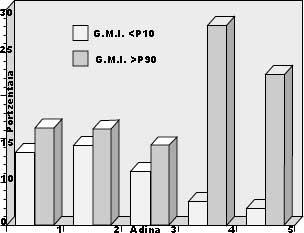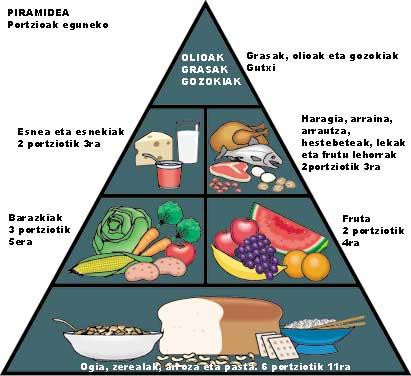Food and child nutrition today: some reflections

Man, like other animals, has suffered food shortages for centuries. One of the most notable exponents of this suffering is the migrations of peoples, such as migrations from the Asian steppes to Europe, which have recently existed from Europe to America (almost half of the Irish population in the last century), and the migrations that are currently taking place from the Third World to the developed world, which have been produced by hunger. Industrial revolution and, above all, II. Since the World War, access to food has been facilitated in the developed world, despite the worsening of the Third World. We could say that in the environment in which we live, and today, most people can access the food they need for the organism, and that, in the absence of disease, should not have nutritional problems (at least not a few).
Perhaps because of the scarcity of food they have suffered for centuries, or because of the very nature of human beings, we are faced with an instinct against hunger that can help us understand the importance that today many people give to food and its environment, especially in terms of the amount of food. Especially in childhood this concern is worrying both in street conversations and in pediatric consultation. Family members often worry more about the lack of food than the basic illness that causes it.
As for quality, we can see the tendency to consume non-native foods. Childhood is no exception, in this way children consume more industrial food than before (meat, industrial pastry,...) etc.) and less our usual meals. Another indicator is natural lactation, discarded by artificial milk between 1900 and 1970 (except in times of war). (We must not forget, even if it seems a lie, that bottle feeding is new, from this century and not eternal).

Children's eating habits have also undergone modifications: schedule, frequency, demand, etc. The way the child eats often reflects the well-being of the family. When the child likes something, he tries to get it and often gets it. They are rage, except that those efforts are “normal”, to get another path that is the favorite, especially when their parents realize that they can not suffer crying or screaming and they give in. In this way, often the child is made on the condition that what we consider as “the best for the child” remains in sight (in most cases? ): we give it to the child as and whenever he wants, according to his will and regardless of his schedule (2 hours and more, adding to the mouth “…otherwise he will die of hunger”). All this is because we have no time or patience to play logically. Especially if in the first years the young child is taught to follow flexible rules, the probability of problems will decrease drastically.
The most regrettable model of the above is the group, known as “caramelos o chucherías”, with the generic name of nutrition “Snack”. Today many children eat every day some sweet and some many. What happened 30-40 years ago only on Sundays, and what was very exceptional, before, has become a day in our society. The excuses for children and young people to consume snacks (including industrial pastry) are very varied: birthday, reward, rage, in exchange for leaving him alone, gift of love to the child, etc. When the child is not so small, he has money in his pocket or gets it to buy what he has learned to consume since childhood, or his successor at the consumer fair. Thus, it is not surprising that pastry shops have grown so much in recent years.
Here are some of the hassles that food can cause and ways to eat, and at the same time, we will try to analyze what has to do with increasing the frequency and severity of these discomfort.
Obesity
Almost the only cause of obesity is the energy imbalance, that is, when the energy that enters the body is greater than that consumed or spent. In our organism we internalize energy through food and its excess is almost always the cause of obesity.
Obese boys are characterized by their little physical activity (not only in sport, but also in all areas of life, for example, they use the car more to go to school in general), more food from noon and a lot of time in front of television. These characteristics are both the causes and the consequences of obesity; on the other hand, lack of physical exercise induces obesity because low energy is consumed; but, in turn, obesity leads to no physical exercise, thus facilitating obesity through this vicious circle.

Obesity has not only been an indicator of health, but also of aesthetics until recently. But obesity has both physical and psychological consequences, especially in childhood. However, its main consequence is the propensity to remain in adulthood, which can cause very negative effects at this age: diabetes, hypertension, heart disease, etc. It is demonstrated that in international studies, even in those carried out in Euskal Herria in recent years, obese children and adolescents have higher levels of blood pressure and cholesterol than others; if to this we add little physical exercise, a type of arteriopathy (heart infarction, cerebral forest disease, etc.) We are aware that you are becoming aware of one of the 3 most important elements to be. But, on the other hand, it is shown that obesity itself is a creator of arteriopathy and does not need the aforementioned consequences to be a risk factor.
In the south of the Basque Country, the highest rate of obese in the Spanish State, along with the rest of the Northern peninsular countries, according to a study conducted in 1984. In the graphs resulting from a study conducted by the Orbegozo Foundation in Bilbao, we can observe in the curves and tables that the parameters and average deviations that measure obesity are greater than those of another curve (Anglo-Saxon in most cases), being our children more obese. According to a pediatrician who works at this Foundation, the sooner the proportion of adipose tissue increases in childhood (age of adipose resuscitation), the infant population will be greater. In the curve of Bilbao, between 4 and 5 years in girls and between 5 and 6 years in boys. While it happens in England, France and the Czech Republic. In his opinion, the above applies equally, even when referring individually to the child; the sooner the adipose resuscitation has occurred, the more likely a child will be to be obese.
In the study carried out in a City Council of Bizkaia, it is observed that in every age today's children have more fat tissue than those of before, that is, they are thicker in general, that is, children of 6 years of today have a greater proportion of fat tissue than those of 5 years ago, what happens in all ages. In addition, the relationship between the percentages of obesity in the different ages is increasing over the years, as shown by the aforementioned study and another prospective study conducted in Navarra. This means that as the year progresses it is more difficult for a fat child to adjust his weight; thus, if a 12-year-old obese is only 25% likely to achieve an adequate weight in adulthood, this proportion is higher in younger and younger in older; it is assumed that among obese adolescents 80-85% will remain obese in adulthood.
Hypercholesterolemia
Atherogenesis lesions, responsible for atherosclerosis and cardiovascular diseases, have demonstrated for more than 30 years numerous studies that definitively begin and evolve in childhood. One of the main responsible is the diet of atherogenesis, which leads to hypercholesterolemia. The most obvious example is the increased frequency of cardiovascular diseases occurring in countries that are changing their diet in the style of developed states, such as China and Nigeria. In atherogenesis, genetic factors (family dyslipidemia, especially hypertension, diabetes) and the environment (atherogenic diets, obesity and its consequences, sedentary lifestyle, smoking) are involved, caused by one or the other.
In childhood, hypercholesterolemia (high and potentially harmful cholesterol) is determined when blood serum cholesterol is greater than 200 mg/dl. A health goal should be to keep cholesterol below this figure and the ldl-cholesterol levels, known as the harmful fraction of cholesterol, below 135 mg/dl.
High cholesterol is much more common in overweight children than in others. In addition, in obese children, the harmful components of cholesterol are high along with triglycerides, while protective supplements (including hdl-cholesterol) are in a much lower proportion.

The increase in cardiovascular disease is certainly related to the change in diet habits. Our diet
it is said that in the rise of sumo is protection against atherogenesis, which are the main components of the Mediterranean diet: vegetable oil (olive, mainly), legumes and fish. These foods are still being consumed, but other foreign foods and habits are gradually being introduced that begin to replace them.
We must also take into account what the child eats between hours: snacks and snacks (including sweets), which today have become responsible for much of the fat and energy of the children’s diet. These fats are very atherogenic as they supply a lot of saturated fatty acids and energy of very poor quality. Among these foods, one group (truffle, industrial sweet, pallets/envelopes) is more atherogenic than the other (nuts, candies). With the changes in diet habits and consumption of these extra foods mentioned many children think that it consumes much more than 30% of the energy recommended in fats and more than 8% in saturated fatty acids, it is not very complicated and therefore is doing an atherogenic diet.
Constipation
There are other physical diseases such as constipation, which are driven by current diet. The lack of fiber in current foods makes the residual mass drier by constipation. In addition, it includes lots of food out of meals with lots of energy (bad energy), no fiber; the energy captured eliminates hunger and therefore virtually no fiber is consumed.
A consequence of constipation is anal fissure. This problem is a typical problem of vicious circle: constipation produces fissure and, if it occurs, constipation is aggravated by increasing pain by releasing dry waste; this increase will increase the fissure or, at least, will not allow its healing.
Conclusions
The discomfort that can be caused with food is very important. Of these discomfort, cardiovascular diseases (asteriosclerosis, heart attack) are the most concentrated. One of the clearest facts to illustrate its relationship with food is that in countries that are converting their diet habits to the Western, a spectacular increase in cardiovascular diseases is occurring. Given the seriousness of the problem, it is surprising that the response that the Health Administrations usually give to themselves is punctual, weak and erroneous. It is sporadic, since instead of being definitive and permanent, it only responds to the concerns of society or journalists. It is weak, as it has only been driven by polls and epidemiological studies scarce of the magnitude of the problem and significant risk factors. Misguided, because those few efforts have been carried out in adult prevention, especially when the problem is pediatric (grow as a child as we have said atheroma plaques, as well as atherogenic foods and harmful eating habits).
I think that we should accept the following points among all the agents (parents, teachers, health personnel, administration...) to logically pose not only the nutrition of children, but also diet, habits.
- Deep education is needed for people to learn which foods and foods are right for our body and which are harmful and preventable. This training should be filled with simple language. In short, you can give advice such as:
- avoid: industrial pastry, very fat meats,
- limit pork products, sausages, eggs, milk and dairy products,
- mandatory consumption: fruit, vegetables, fish, olive oil,
- Do not forget the snacks that children eat beyond meals.
- In addition to food, it is essential to control the behavior of parents since they will transmit to their children the customs, so they like the child, but of all food groups, in the established hours and in a logical time (half an hour, 3 quarters of an hour), without forcing to eat and without offering anything until the next hour of food.
- It is essential to encourage natural lactation, providing adequate nutrients and avoiding some diseases, as it is an example of natural feeding and facilitates healthy habits for the future.
- Physical exercise must be encouraged, especially through street games; the main and almost unique entertainment of the house has become watching television and we have already mentioned the consequences of this action.
- In advertising so strongly in society (ads are effective in conveying the message and affect a more or less general audience), public institutions should act firmly to promote health habits on the diet. In addition, it would be necessary to limit advertising on diet and, therefore, health, avoiding or modifying the false message of some advertisements, especially when there are many ads that target the consumption of bad and inadequate food (who does not know “donate… to grow in length and not in width from 3 months”, or “take the food of champions”, or I have forgotten the way “aiba, …”)
Or, on the other hand, the current fashion of being thin. In this respect we can say that the inadequate propaganda in favor of slimming (example of body of a name of yogourt, actor or actress...) is aimed at the consumption of inadequate food; slimming creams, light food for weight loss, etc. ). Of course, this should also have thorough control.
Buletina
Bidali zure helbide elektronikoa eta jaso asteroko buletina zure sarrera-ontzian











